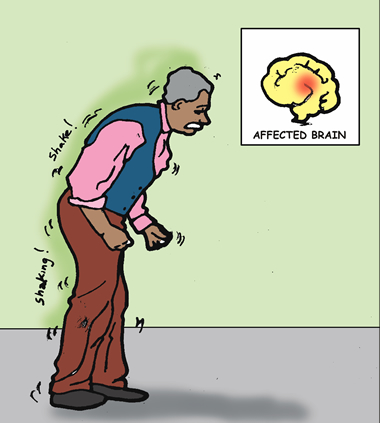Okay, don’t panic you come to the right place!
First of all, Parkinsonism simply means you have features of Parkinson’s disease (PD) but not the entire clinical picture based on the UK a brain criterion which includes 4 main symptoms: rest tremor; rigidity (stiffness); bradykenisia (slowness); and gait abnormality. Usually people labeled ‘parkinsonian’ have two or three of these features.
What Causes This?
3 scenarios are possible for why this occurs.
1) You either have an underlying illness which affects the basal ganglia – structure involved in PD – which then mimics PD. Things that affect these structures of the brain whether it’s through blood loss, loss of oxygen, pressure, swelling from trauma or infection can then mimic symptoms of Parkinson’s because remember the basal ganglia is important in movement, learning and balance. So common primary neurological diseases like strokes, multiple sclerosis, brain tumors must be ruled out and can be a reason why you have received a diagnosis of Parkinsonism. Non- neurological causes which can affect the brain are things like lupus which cause brain inflammation and other types of infections such as lymes disease or syphilis, and HIV. NPH (Normal pressure hydrocephalus) and lower body parkinsonism caused by multiple strokes (considered to be its own disease type) can be other less known causes of parkinsons-like symptoms in an individual. This is why we often order an MRI of the brain at time of diagnosis as well as lumbar puncture / spinal tap to make sure no infections are present.
or
2) Your Parkinson’s disease is very early in its presentation at time of first evaluation and has not developed all of its features; this is especially common in younger people with YOPD who may present usually with dystonia (abnormal contraction of muscles) along with more non- motor symptoms in conjunction with stiffness and slowness. I have had many young patients take 5 years or longer to present with full blown PD symptoms- initially receiving diagnosis of Parkinsonism or focal even segmental dystonia. I myself did not start having rest tremors till 7 years after onset of other PD symptoms; even now my rest tremors are not very prominent. They are more pronounced in my toes than in my hands which is not very common or typical.
or
3) You may have an atypical Parkinson’s syndrome or Parkinson’s plus disease such as Lewy body dementia (LBD), corticobasalganglia degeneration (CBGD), progressive supranuclear palsy (PSP), multi system atrophy (MSA) which could either be Shy-drager or olivopontocerebellodegeneration or atrophy (OPCA). All of these “atypical” PD illnesses take time to develop into full blown disease that can be recognized sometimes even by experts if the right “key” feature is not present from the beginning like “alien-hand” is characteristic of CBGD. Plus we must remember there are many other hereditary illnesses which are less typical and common that can present this way some of which may not have characteristic imaging findings and can’t be recognized unless an expert does a specific blood test such as SCA6 . However, because we don’t have a diagnostic blood test or an objective way of differentiating among the various types of Parkinson’s we must rely on the ability of MDS doctors to recognize the other clinical signs which point to the fact that one is not dealing with ‘typical’ Parkinson’s disease. The signs and symptoms such as dementia, memory loss, personality changes, or apathy from the beginning of disease, bladder issues severe and out of proportion for time of other symptoms like tremors, stiffness .as well as greater swallowing difficulties, increase falling, speech impediments, difficulty with coordination or action tremors are all signs that we are dealing with a Parkinson’s plus syndrome. In this category, a good MDS can be of great benefit. He or she should be able to tell that your Parkinsonism is due to an atypical syndrome as opposed to a secondary cause like in 1. However, knowing a person has a Parkinson’s plus syndrome and being able to pinpoint with 100% certainty which one may still require frequent visits with your physician.
Getting A Dat scan does not help in these situation because all it can tell you is that there is a dopamine problem if normal it would only point to a non -dopaminergic cause and if MRI normal- NPH, infection (individual would be sick with fevers, rash etc), and even psychogenic causes need to be entertained.
Treatments:
At this point since we do not have an assortment of drugs to treat different types of Parkinsonism or to treat even between the different subtypes of PD the treatment is always Levodopa! All types of Parkinsonism except psychogenic requires levodopa. However, the prognosis for each and the amount of response vary on the type and underlying cause. The best response to levodopa is with typical PD- a big clue for physicians.
The key to successful treatment is early initiation of medication independent of cause except psychogenic/stressed induced. Since if its early PD – the sooner the treatment the better the prognosis and greater quality of life, if its Parkinson’s plus it will initially give quality but because of nature of disease it will progress independent of medication and will not lose anything by starting dopa early. In the one’s caused by an underlying disease, patients will fell symptomatically better but once underlying disease or culprit found they may or may not need further dopa but if they do unlike the other dopaminergic illnesses there will not be a need for escalation of does and medications because symptoms are for the most part static.
Nevertheless, all Parkinsonism patients will benefit from a neurologist care. Those with Parkinson’s and those with Parkinson’s plus syndromes need a movement disorder specialist which can manage the subtleties as well as coordinate a team care approach. Those with Parkinsonism due to other underlying cause need to seek care from a specialist in that area such as stroke doctor, MS specialist, or rheumatologist. In some cases, the Parkinsonism can resolve completely once cause is identified like treating infection or NPH.
This is why it is extremely important to seek initial treatment with a neurologist and follow- up with the same person consistently in order to increase as well as expedite accurate and proper diagnosis.


I was diagnosed with hemi-parkinsonism, hemi dystonia, and hemi athrophy,in1987! But I am like that since birth and was born in 1948!!
i am sorry to hear but this is congenital right? so still treat with all new pd meds except that you would nor be classified as pd idiopathic and i am sure that is not progressed in the way that idiopathic pd does meaning nonmotor symptoms, fluctuations and cognitive decline – thanks for sharing and hope you are well
some cases are related to birth and these cause disability gradually over time – if causing problems there are several treatments like dbs, botox, or baclofen intrathecal but this is not parkinson’s idiopathic disease – is not a progressive neurodegenerative problem although may be treated with similar agents